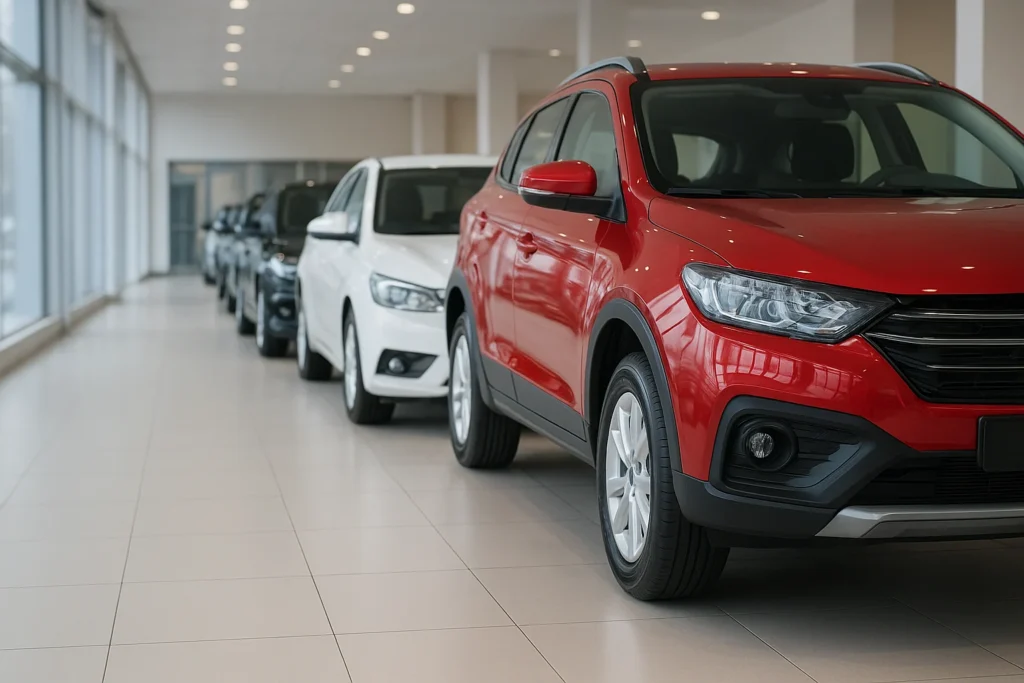Prologue: The Wheels of Change
The year was 1947. As India gained independence, its roads were dominated by a handful of British-era vehicles – the stately Hindustan Ambassador, the rugged Willys Jeep, and the occasional imported luxury car. Fast forward to 2025, and the transformation is nothing short of revolutionary. The announcement that India had surpassed Japan to become the world’s third-largest automobile market marked the culmination of an extraordinary journey – one that began with hand-assembled vehicles and has now positioned India at the forefront of global automotive innovation.
This is not just a story of economic growth, but of a nation’s relentless pursuit of progress. From the first Maruti 800 that put a car within reach of the middle class, to the cutting-edge electric vehicles rolling off assembly lines today, India’s automotive evolution mirrors its broader economic and technological transformation.
Book I: The Foundations (1947-1990)
Chapter 1: Birth of an Industry
In the smoky workshops of Mumbai and Kolkata, India’s automotive story began. Hindustan Motors’ Uttarpara plant became the cradle of Indian automobile manufacturing, giving birth to the iconic Ambassador in 1958. With its:
- British Morris Oxford roots
- Unmatched durability
- Spacious interiors
It became the vehicle of choice for government officials and taxi operators alike.
Meanwhile, Premier Automobiles licensed the Fiat 1100, creating the beloved Padmini that would dominate Mumbai’s taxi stands for decades.
Chapter 2: The Constraints of License Raj
The period from 1960-1980 saw minimal growth due to:
- Restrictive industrial licensing
- Prohibitive import duties (up to 350%)
- Limited foreign collaboration
Resulting in: - Outdated technology
- Poor quality standards
- Minimal consumer choice
The waiting period for an Ambassador could stretch to 10 years, making car ownership a distant dream for most Indians.
Book II: The Liberalization Era (1991-2010)
Chapter 3: Maruti Suzuki – The People’s Car Revolution
The 1983 launch of Maruti 800 changed everything:
- ₹48,000 price tag (about $400 then)
- 800cc engine with 20 kmpl mileage
- First car with modern features like AC
Annual sales jumped from 30,000 to 200,000 units in just five years.
Chapter 4: Economic Reforms Reshape an Industry
The 1991 reforms brought:
- Abolition of license-permit raj
- 51% foreign direct investment allowance
- Reduced import tariffs
Leading to an influx of global players: - Hyundai (1996) with Santro
- Honda (1997) with City
- Toyota (1999) with Qualis
Chennai emerged as the “Detroit of India” with massive investments from Ford, Hyundai and BMW.
Book III: The Boom Years (2010-2020)
Chapter 5: Indian OEMs Come of Age
Tata Motors’ milestones:
- 1998 Indica (first fully Indian passenger car)
- 2008 Nano (the “1 lakh car”)
- 2008 Jaguar Land Rover acquisition
Mahindra’s rise as SUV leader with Scorpio and XUV500.
Chapter 6: Manufacturing Revolution
Key developments:
- Annual production crossed 3 million units
- Component industry grew to $30 billion
- India became global export hub for small cars
Chapter 7: Changing Consumer Preferences
The dramatic shift from:
- Basic transportation → Lifestyle statement
- Fuel efficiency → Feature richness
- Sedans → SUVs
SUVs grew from 15% to over 50% of passenger vehicle sales.
Book IV: The Electric Revolution (2020-Present)
Chapter 8: Policy Framework for Change
Landmark initiatives:
- FAME Scheme: ₹10,000 crore incentive package
- PLI Scheme: ₹57,042 crore for advanced auto tech
- Battery Swapping Policy
Chapter 9: Market Leaders Emerge
- Tata Motors: 72% EV market share with Nexon EV
- MG Motors: ZS EV success story
- Ola Electric: Disrupting two-wheeler segment
- Tesla’s Entry: Confirmed factory by 2026
Chapter 10: Charging Infrastructure Growth
Current status:
- 6,586 public charging stations
- Target: 46,000 by 2030
- Battery swapping stations in 20 cities
Book V: The Current Landscape (2025)
Chapter 11: Market Segmentation
| Segment | Market Share | Growth Rate |
|---|---|---|
| SUVs | 52% | 18% YoY |
| EVs | 6.6% | 157% YoY |
| Luxury | 1.2% | 25% YoY |
Chapter 12: Top Selling Models
- Hyundai Creta
- Maruti Suzuki Brezza
- Tata Nexon EV
Chapter 13: Export Powerhouse
Key markets:
- Africa (35% of exports)
- Latin America (28%)
- ASEAN (22%)
Book VI: Technological Frontiers
Chapter 14: Connected Vehicles
- 25% new cars have telematics
- Jio-Google partnership for in-car systems
Chapter 15: Autonomous Driving
- Mahindra testing Level 3 autonomy
- Bangalore-Mumbai expressway AV lanes
Chapter 16: Hydrogen Economy
- Ashok Leyland fuel-cell buses trials
- Reliance gigafactory for green hydrogen
Book VII: Supply Chain Evolution
Chapter 17: Localization Drive
Current status:
- 85% localization for ICE vehicles
- 45% for EVs
- Target: 90% by 2030
Chapter 18: Semiconductor Strategy
- Tata Electronics fab in Gujarat
- 4 design centers in Bengaluru
Book VIII: Human Capital Development
Chapter 19: Skill Initiatives
- NATRiP (National Automotive Testing Centers)
- ASDC (Automotive Skills Development Council)
- 25 new automotive engineering colleges
Chapter 20: Workforce Statistics
- Direct employment: 8 million
- Indirect employment: 35 million
- Women workforce: 18% (up from 5% in 2010)
Book IX: Sustainability Roadmap
Chapter 21: Emission Targets
- BS7 norms by 2030
- Carbon neutrality by 2070
- 30% recycled materials in manufacturing
Chapter 22: Circular Economy
- 95% vehicle recyclability mandate
- 2,000 authorized recycling centers
Book X: Global Partnerships
Chapter 23: Strategic Alliances
- Suzuki-Toyota tech sharing
- Tata-VW platform sharing
- Mahindra-Ford joint ventures
Chapter 24: Foreign Investments
- Tesla’s $5 billion plant in Gujarat
- VinFast’s $500 million Tamil Nadu unit
- BYD’s R&D center in Hyderabad
Book XI: Challenges Ahead
Chapter 25: Key Hurdles
- Raw material security (lithium, cobalt)
- Urban congestion (35% productivity loss)
- Financing constraints (high interest rates)
Chapter 26: Competitive Landscape
- Chinese automakers’ price war
- Japanese hybrid technology lead
- European luxury dominance
Book XII: Future Projections (2030 Vision)
Chapter 27: Market Size Estimates
- $300 billion industry
- 7.5 million annual sales
- 3 million direct jobs
Chapter 28: Technology Milestones
- 15% autonomous vehicles
- 30% EV penetration
- 50% connected cars
Book XIII: Regional Development Hubs
Chapter 29: Major Clusters
- Chennai Corridor: 35% of production
- Pune-Belgaum Belt: 25% share
- Gujarat Cluster: Emerging EV hub
Chapter 30: State-wise Policies
- Tamil Nadu’s EV manufacturing incentives
- Karnataka’s R&D tax benefits
- Maharashtra’s scrappage policy
Book XIV: Consumer Behavior Shifts
Chapter 31: New Purchase Drivers
- Sustainability (42% buyers)
- Tech features (38%)
- Brand value (20%)
Chapter 32: Ownership Models
- Subscription services growing at 45% CAGR
- Shared mobility $15 billion market by 2030
Book XV: Financial Ecosystem
Chapter 33: Funding Landscape
- $7 billion VC investment in auto-tech
- 15 auto-focused PE funds
- Nifty Auto index outperformance
Chapter 34: Insurance Innovations
- Pay-per-kilometer policies
- EV-specific coverage products
- AI-driven claim processing
Book XVI: Cultural Impact
Chapter 35: Motorsports Growth
- Formula E Delhi ePrix
- Indian Rally Championship expansion
- 5 new racing circuits
Chapter 36: Cinematic Influence
- 35% of Bollywood films feature EVs
- Automotive content creators (5 million followers)
Epilogue: The Road Ahead
As the sun sets over the Maruti Suzuki plant in Gurugram, casting long shadows over rows of freshly manufactured vehicles ready for export, it’s clear that India’s automotive journey is far from complete. The industry stands at an inflection point where every decision today will shape mobility for generations to come.
The challenges are formidable but not insurmountable:
- Building sustainable supply chains
- Developing indigenous technology
- Creating inclusive mobility solutions
- Maintaining global competitiveness
Yet, if the past seven decades have taught us anything, it’s that India’s automotive sector thrives on challenges. From the humble Ambassador to the sophisticated EVs of today, each era has built upon the last, creating a resilient, innovative industry capable of surprising the world.
As India accelerates toward its ambition of becoming the global automotive leader, one thing is certain – the road ahead will be as exciting as the journey so far. The wheels are in motion, and the world is watching as India shifts into high gear on its path to automotive supremacy.




c5sxk9